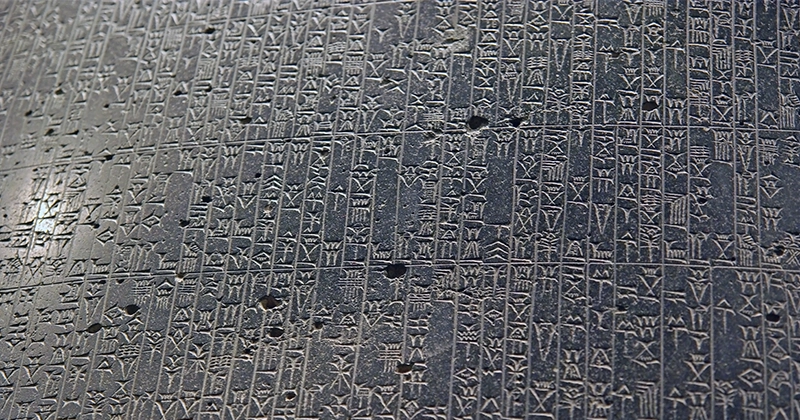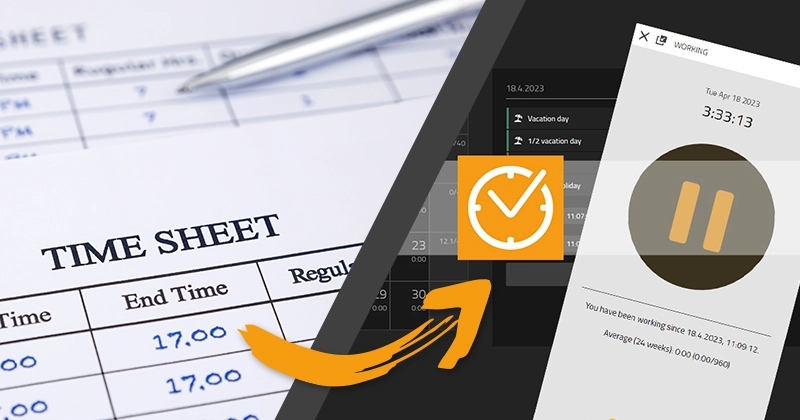
The tracking of working times – also in form of attendance registers – is not a recent invention. The very first document which tracked working times, tasks and salary for various jobs stems from 1772 BC. It is the Code of Hammurabi, one of the oldest written collections of statutes of the Babylonian civilization1.
With this codex as a basis, similar attempts were undertaken by the Egyptians, Greek, Chinese and Romans. Even though these systems provided daily wages, they are undoubtedly the predecessors to the time stamp.
In the past, many tasks followed the natural cycle of the seasons and the sun. Working times would often be regulated via church bells and public clocks. With the Middle Ages, in medieval Europe, it became common practice to keep detailed records on paper of the working hours. This practice was especially widespread amongst craftsmen, apprentices and the various guilds.

Code of Hammurabi
In the 19th century, with the beginning of the Industrial Age, the more flexible recording of working hours was replaced by a stricter handling and standardization of working hours. Factory workers who had originally left the countryside to earn a better living in the big cities, suddenly had to stand in line every morning to get registered for the day. Entrepreneurs employed staff with the sole task to document the entry times of the employees. These entry times were recorded on paper registers – the predecessors of our modern Excel spreadsheets.
In 1879, the German inventor Richard Bürk applied for a patent for a device to register the presence times of employees. This device mechanically recorded the working hours of employees in the factory. However, the apparatus could easily be manipulated and was much too expensive due to excessive paper consumption. This was the reason why he eventually developed the so-called “Billeteur” with which the working hours were stamped onto a card.
The origins of the first mechanical clocking machines date back to the end of the 19th century. Within just a few years, the gentlemen Bundy, Dey and Cooper developed three different methods to record attendance:
At first, all three only followed their own ideas. Bundy and Bürk then started a collaboration and founded a company, before all three of them eventually joined forces. In the 1920s, the company received the name IBM (International Business Machine)2. Recently established, IBM already had quite a portfolio: Punch cards, scales and slicing machines and clocking machines – which were manufactured by the company for over 40 years. In 1938, IBM developed a fully automatic time recorder. Up until the 1960s, the company remained interested in time recording systems. After that, the focus shifted to the first computers, introducing the Digital Age.
Over time, the documentation of working times became increasingly important, especially to ensure fairness and transparency. The further development of time recording systems reflects technical progress as well as the social and economic changes within society, also in relation to labor.
A common but unsuitable method. Pads of paper are easy to use and you can take them along with you. However, this method is highly time-consuming and the pads can quickly get lost or damaged.
Small, fabulous piece of hardware. The system is not cheap. Maintenance and repairs may become necessary.
First gamechanger. Every employee can access the system via the own computer.
During the digital transformation, companies have developed systems to record the working times. These contain many useful functions and help HR with the administration and management of the times. Yet, many – especially smaller firms – still use electronic recordings for the hours worked, oftentimes in form of excel sheets.
These traditional methods, however, also have some disadvantages:
With progressive digitization, these traditional methods to record working times continue to disappear from our offices. They are replaced by apps or badge systems. The conditions have changed fundamentally over time. Just a few years ago, it was unheard of that employees would work remotely from home and outside the office surroundings, while still managing their working hours in a digital fashion. The landmark “time-clock ruling” from the European Court of Justice (ECJ) a few years ago brought about the requirements of systematic time recording for the European member states.
Ever since this ECJ ruling in 2019, member states have been making amendments to meet the legal requirements. Although legal provisions vary from country to country, European employers are required to implement an “objective, accessible and reliable system” to record the daily working hours of each employee.3

The Working App is the ideal business tool for employees to digitally document their working hours via desktop, browser or smartphone. Working times as well as break times can conveniently be recorded in real-time via the user-friendly myApps interface. Once entries are submitted, they can no longer be edited, making them tamper-proof. Automated notifications help employees adhere to working time regulations with break times and rest periods, as well as working on Sundays or public holidays. The consists of two parts: one app is for the user to record the working times (Working User App), the second is for HR purposes, to manage administrative tasks related to the recording of working hours (Working Manager App).
We have plenty more information on our website concerning the features of the Working App.
A lot has happened in recent years and plenty of await us in the near future. Companies across Europe need to come up with a roadmap to cover the legal aspects concerning the recording of working hours. However, with innovaphone, there is no cause for concern. If you are still unsure how to approach this topic, please get in touch with us, we will be pleased to talk you through everything.
1 https://en.wikipedia.org/wiki/Babylonia
2 https://en.wikipedia.org/wiki/IBM
3 Legal content database EUR-Lex
Should you have any questions concerning the innovaphone Working App, please to not hesitate to get in touch with us.